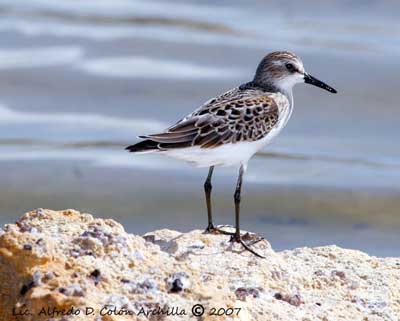
Semipalmated Sandpiper
Calidris pusilla
Charadriiforme Order – Scolopacidae Family
BIOMETRICS:
Length: 13-15 cm
Wingspan: 34-37 cm
Weight: 20-40 g
LONGEVITY: Up to 12 years
DESCRIPTION:
Semipalmated Sandpiper is slightly smaller than Western Sandpiper (Calidris mauri), with black, shorter, straight bill, thick at base and less pointed tip.
Breast sides are streaked. We can see narrow white wing bar. Legs are blackish.
During the breeding season, the upperparts are blackish-brown, with cinnamon edges, and the streaked breast is darker.
Outside the breeding season, plumage is rather pale grey with paler belly.
PROTECTION / THREATS / STATUTS:
Populations are not threatened, but they are vulnerable to destruction and degradation of coastal habitat, and disturbances dues to human developments.
Fr : Bécasseau semipalmé
All : Sandstrandläufer
Esp : Correlimos Semipalmeado
Ital : Piro-piro semipalmato
Nd : Grijze Strandloper
Russe : Малый песочник
Sd: Sandsnäppa
Photographers:
Alfredo Colón
Puerto Rico Wildlife
Bob Moul
Nature Photography
Tom Grey
Tom Grey's Bird Pictures
Texte de Nicole Bouglouan
Sources:
HANDBOOK OF THE BIRDS OF THE WORLD Volume 3 by Josep del Hoyo-Andrew Elliott-Jordi Sargatal - Lynx Edicions - ISBN : 8487334202
SHOREBIRDS by Peter Hayman, John Marchant and Tony Prater – Christopher Helm – 1986 – ISBN: 0747014035
GUIDE DES LIMICOLES de D. Taylor - Delachaux et Niestlé - ISBN : 2603014080
The Birds of North America online
Wikipedia (Wikipedia, The Free Encyclopedia)

When in flight, the bird shows white band on wings and white outer rectrices.
Bill is black. Eyes are dark brown. Legs and partially webbed feet are blackish.
Female is slightly larger than male.
Non-breeding adult has grey-brown upperparts. Crown is dark brown, as the eye stripe. Face is white. Flanks and breast are white too.
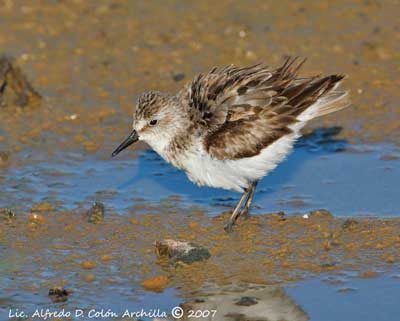
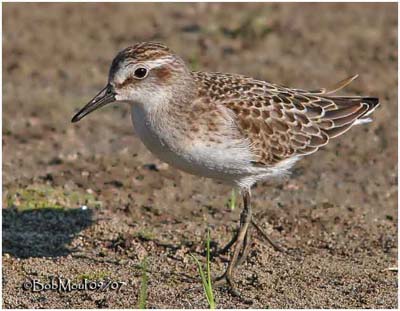
Juvenile has tinged rufous scapulars and mantel.
Semipalmated Sandpiper’s name is for the partial web joining the base of the toes.
VOICE: SOUNDS BY XENO-CANTO
When in flight, the Semipalmated Sandpiper utters typical song, a short and low “chruup” or “krrit”, and a short, high-pitched “kit”.
HABITAT:
Native to North America, the Semipalmated Sandpiper nests in the wet and grassy tundra, often near pools and lakes. It also may nest in tidal areas, and sandy beaches. We also find it in lake and pool’s mudflats.
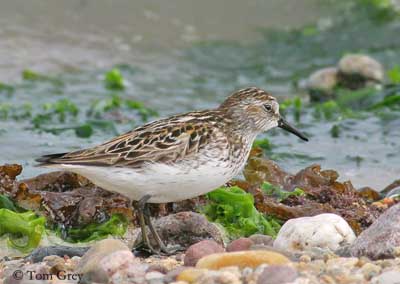
RANGE:
Semipalmated Sandpiper breeds as far as western Alaska and northern Canada. It migrates through United States, in order to reach the wintering areas situated in Pacific coasts, from Mexico to Peru, and in Atlantic coasts, from Yucatan to Caribbean and Argentina.
BEHAVIOUR:
Semipalmated Sandpiper forages mainly in shallow water and muddy shores. It pecks about and dabbles with dropped head, instead to probe deeply.
It feeds in flocks on tidal areas. It walks and runs rapidly, pecking and digging the soil with the bill. Occasionally, it may probes between the soft muddy area and the water, with rapid movements similar to a sewing machine.
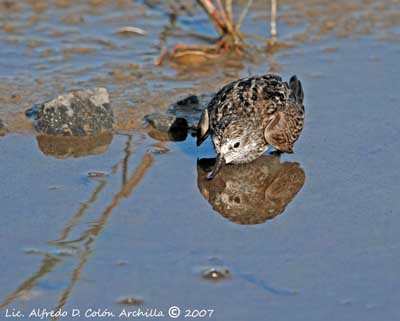
Semipalmated Sandpiper is highly gregarious. We can see flocks of up to 350 000 birds at stopover sites.
But is the food sources are reduced, it becomes aggressive against the other birds, and some quarrels may occur when they defend their feeding territory.
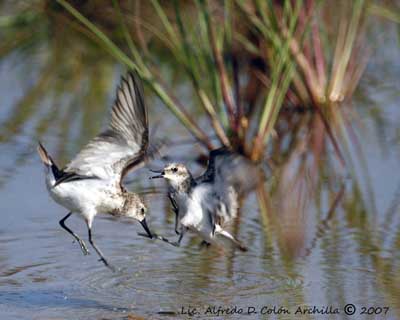
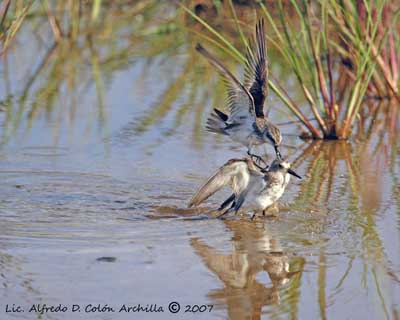
Semipalmated Sandpiper is long-distance migrant, able to travel over distances of up to 4000 km without any stopover.
The male arrives first on the breeding areas, and starts to establish the territory and its boundaries. Pairs are monogamous and form as soon as the female arrives.
This species returns every year to the same nesting area.
FLIGHT:
Semipalmated Sandpiper is able to fly non-stop over long distances when migrating.
REPRODUCTION:
Semipalmated Sandpiper male digs several depressions in different locations, and the female chooses the nest-site which they arrange together.
The nest is lined with dry leaves, grass and moss. It is often situated on top of islet, on furrow, near pool or along the coast, under willow or birch, or in tussock.
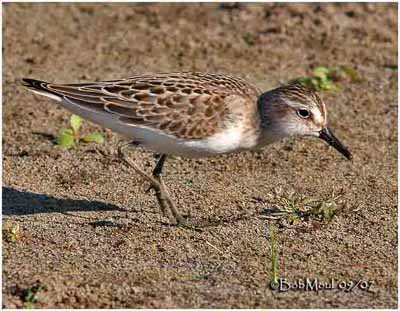
The female lays 3-4 brown eggs, speckled dark brown, between June and early July. Incubation lasts about 18 to 22 days, by both parents.
Female usually leaves male and chicks about 2-10 days after hatching. Chicks leave the nest very soon and are able to feed themselves.
The male also starts to migrate, leaving the young alone. They can fly at about 19 days, after some short flights 4-5 days before. They follow the adults about one month later.
DIET:
Semipalmated Sandpiper feeds on aquatic insects, flies and larvae, spiders, snails and seeds during the breeding season.
During winter and migrations, it consumes small crustaceans, molluscs, marine worms and algae, and also takes some terrestrial invertebrates.